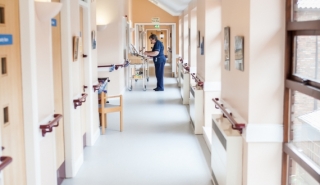In this section
Colposcopy
A colposcopy is a simple procedure used to look at the cervix, the lower part of the womb at the top of the vagina. It's often done if cervical screening finds abnormal cells in your cervix or a doctor feels that a more detailed assessment of cervix is required.
Why do I need colposcopy?
You may be referred for a colposcopy within a few weeks of cervical screening if:
- Your cervical screening sample are abnormal
- The nurse or doctor who carried out the screening test thought your cervix didn't look as healthy as it should
- It wasn't possible to give you a clear result after several screening tests
Colposcopy can also be used to find out the cause of problems such as unusual vaginal bleeding (for example, bleeding after sex).
Try not to worry if you've been referred for a colposcopy. Being offered colposcopy does not mean that you have cancer, most women who have colposcopy will not go on to develop cervical cancer. Any abnormal cells won't get worse while you're waiting for your appointment.
If you are pregnant please let the colposcopy team know, as it may still be necessary to perform the colposcopy examination. The colposcopy examination does not harm a pregnancy.
Human Papilloma Virus (HPV)
HPV is a very common virus. Most people will have been exposed to HPV at some point in their lives. HPV can easily be passed between people during intimate contact, but it should not be considered in the same way as a sexually transmitted infection.
There are many different sub-types of HPV. Some sub types of HPV are very strongly related to the development of abnormal cells (CIN, see below) within the cervix. When the laboratory processes your cervical smear sample two things are tested:
- The presence or absence of abnormal cells.
- The presence or absence of sub-types of HPV that effect the cervix, so called high-risk HPV.
If an abnormality in the cells is detected along with the presence of high-risk HPV you will be referred to colposcopy for further assessment.
There isn’t a medical treatment to get rid of the HPV virus. For most women, their immune system will get rid of the HPV. It has been demonstrated that stopping smoking can improve the immune system’s ability to get rid of HPV.
What does colposcopy involve?
A colposcopy examination is usually carried out in a hospital clinic. It takes about 15-20 minutes and you can go home the same day.
During the colposcopy examination:
- You undress from the waist down (a loose skirt may not need to be removed) and lie down in a special type of chair with padded supports for your legs
- A device called a speculum is inserted into your vagina and gently opened
- A microscope with a light is used to look at your cervix – this doesn't touch or enter your body
- Special liquids are applied to your cervix to highlight any abnormal areas
- A small sample of tissue (a biopsy) may be removed for closer examination in a laboratory – this may be a bit uncomfortable
After your colposcopy examination:
- Most women feel well enough to go about their day-to-day activities straight away, but sometimes you may need to go home and rest for a short while.
- You may notice some brown coloured discharge from the vagina afterwards from the liquids used during the colposcopy, this will settle soon after.
- If you have had a biopsy you may have some light bleeding or discharge from the vagina, this would usually settle in 3-5 days.
Colposcopy results
At the time of colposcopy examination the nurse or doctor may be able to tell you what has been found. If a biopsy has been taken it will need to be checked in the laboratory. If this happens, you will receive the results by post within 3-4 weeks of the appointment.
On your first visit for colposcopy you may be offered treatment for abnormal cells on the cervix, this is called ‘see and treat’. This may occur when you have an abnormal smear and the colposcopy examination detects changes consistent with high grade CIN. Please see the sections below for further information about CIN and treatment.
What if my result is normal?
About 4 in every 10 women who have a colposcopy examination will have a normal result.
If the colposcopy (and/or biopsy from the cervix) is normal then it means your cervix is healthy and no further action is required. You would then be invited back for cervical screening in 3 or 5 years depending on your age, as usual.
You can have a normal colposcopy result even if you had an abnormal result in your cervical screening test.
What if my result is abnormal?
About 6 in every 10 women who have a colposcopy examination will have an abnormality of the cells of the cervix. The medical term for this is CIN (cervical intraepithelial neoplasia) or CGIN (cervical glandular intraepithelial neoplasia). CIN and CGIN are not cancer, but sometimes could develop into a cancer of the cervix.
The colposcopy and biopsy results will provide the doctor or nurse with the information needed to determine if the abnormal cells should be removed or whether they can be left alone for now. This will depend on whether the CIN is low grade or high grade.
- Low grade CIN (also called CIN1) is very unlikely to develop into cervical cancer. Most often the abnormal cells will go away without treatment; if you are a smoker stopping smoking makes this more likely. You would normally be asked to have another cervical screening test (“smear”) in 12 months to check that the abnormal cells have gone away.
- High grade CIN (also called CIN 2 & CIN 3) has a higher chance of developing cervical cancer and so you would normally be offered a treatment to remove the abnormal cells to reduce the risk of developing cervical cancer. You would usually be offered a treatment to remove the abnormal cells if CGIN had been detected also.
Sometimes after colposcopy examination a woman will be diagnosed with cervical cancer. If you are found to have cervical cancer, you will be offered further investigation and treatment from a team of specialists. Fortunately, cancers found through screening tend to be detected at an earlier stage with a better prognosis.
What does treatment to remove abnormal cells in the cervix involve?
The usual treatment for high grade CIN or CGIN is to remove the abnormal cells from the cervix taking care not to damage the healthy parts of the cervix.
There are several simple and effective treatments that can be used to remove the abnormal cells, including:
- Large loop excision of the transformation zone (LLETZ) – a heated wire loop is used to remove the abnormal cells
- A cone biopsy – a cone-shaped piece of tissue containing the abnormal cells is cut out from your cervix
LLETZ is usually carried out while you're awake in the colposcopy department. Your cervix is numbed with local anaesthetic. It usually takes no longer than 10 minutes and you can usually go home straight after.
A cone biopsy is usually done under general anaesthetic (where you're asleep) and you may need to stay in hospital overnight but usually would be able to go home the same day.
You'll usually be advised to avoid:
- Driving for at least 24 hours if you had a general anaesthetic – you can drive straight away if a local anaesthetic was used
- Using tampons for four weeks (use sanitary pads instead)
- Having sex for four weeks
- Exercising, including swimming, for at least two weeks, or while there's still any bleeding or discharge
After treatment you would be asked to have a cervical screening test (“Test of cure smear”) six months later to check that the treatment was successful. About 4 in every 5 women will have a normal test after treatment. Those with a cervical screening abnormality are invited back to colposcopy but very few of these require further treatment.
What are the risks of treatment to remove abnormal cells from the cervix?
The treatments are safe and effective but occasionally some women may experience problems after treatments such as LLETZ or cone biopsy. Common side effects of treatment include:
- Mild pain, similar to period pain – this should pass in a few hours and can be relieved with paracetamol or ibuprofen
- Light vaginal bleeding and brown, watery vaginal discharge – this may last up to four weeks
There's also a small risk of more serious complications, such as:
- An infection – this can cause heavy or persistent bleeding, smelly vaginal discharge and persistent tummy pain; see your GP if you have these symptoms
- A slightly increased risk of premature birth (before the 37th week of pregnancy) in future pregnancies – this is more likely if you need repeated treatments or a lot of tissue needs to be removed
In most cases, the benefit of treatment will outweigh these risks. Talk to your doctor or nurse if you have any concerns or would like to know more about the potential risks of treatment.
Other treatments
Cryotherapy
Cryotherapy is another form of treatment offered in the colposcopy department. This type of treatment can be offered when a person has problems with bleeding after sexual intercourse, rarely it may be offered to treat low grade CIN changes.
Cryotherapy treatment is performed in the colposcopy suite. During the treatment a cold probe is applied to the cervix for a few minutes. During the treatment you may experience some mild period type cramps but it is unusual for the procedure to be associated with any significant pain.
Following cryotherapy you might have some discharge for a few weeks as the cervix heals. During this time there is a small risk of infection so if the discharge becomes smelly please seek advice from your GP.
Your colposcopist will give you advice regarding the follow up you need after the cryotherapy treatment.
Useful Links
Contact us
To book an appointment with Colposcopy Clinic or discuss your appointment please contact our Colposcopy helpline on 01904 726705, available Monday to Friday, 8.00am to 5.00pm. There is a voicemail for out of hours.
Colposcopy appointments
Monday to Friday 8.00am to 4.00pm
Voicemail service available
01904 726705






